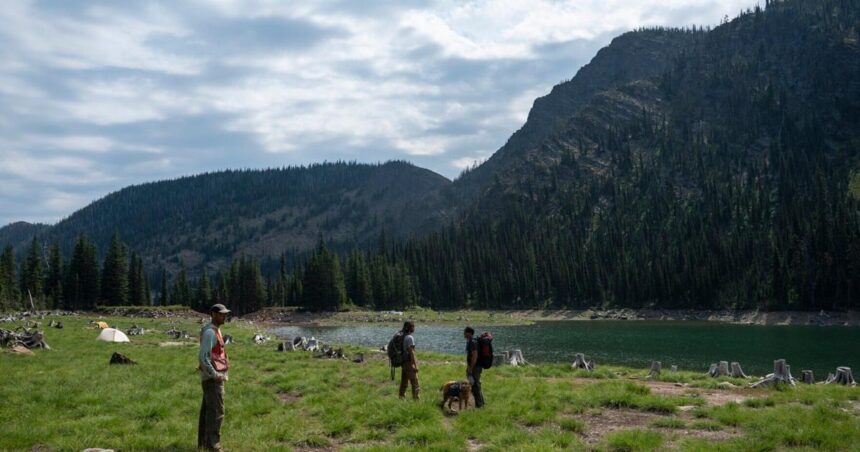After a last check of the explosive charges, U.S. Forest Service blaster Steven Petesch and two other explosives experts scooted around McKinley Lake’s shoreline deep in the Rattlesnake Wilderness, ready to breach an archaic, 100-year old dam.
The blasting team dug several 5-foot holes for the explosives into the ground, covered each charge and connected them to the detonation system using a thin cord. A team of conservation workers awaited anxiously atop a glacial boulder above the lake, unsure what to expect.
Three. Two. One, and Petesch pressed the remote detonation button.
The middle of the damn erupted in a barrage of dirt, rocks and logs that shot hundreds of feet into the air. A dust plume enshrouded the lower half of the lake. Giant rocks landed 200 feet away.
When everything settled, the real work began.
People are also reading…
“It looked like no man’s land for a while,” Missoula Associate Director for Ecosystem Services Morgan Valiant said as he stood in a school bus-sized gap between the slopes of the remaining dam.
This summer the city of Missoula, Trout Unlimited and the Forest Service teamed up to decommission one of 10 old dams beneath the peaks of the Rattlesnake Wilderness.
When Missoula established its public water system a century ago, the lakes served as a backup source for the town. But with decades gone by, most of the dams no longer function, and there is a new effort to rewild the original ecosystem.
“The whole goal is to restore this lake to its natural state,” said Rob Roberts, senior project manager for Trout Unlimited, a national nonprofit dedicated to conserving and restoring America’s cold-water fisheries.
After years of planning and regulation approvals, the project took off this summer and will soon be completed. For years to come, McKinley Lake will look as it did before the dam, dropping from 17.5 to 12 acres.
The city spent $100,000 to fund the project, while the Montana Department of Natural Resources and Conservation, Montana Fish, Wildlife & Parks and the Resources Legacy Fund provided grant money.
The project also served as a test run for the remaining reservoirs that the city owns. Organizers said the decommissioning this summer was extremely successful. But like any effort in the backcountry, it wasn’t easy.
Missoula’s water
Between 1911 and 1923, the Missoula Light and Water Company built 10 dams on the high alpine lakes in the Rattlesnake, decades before the area was designated as wilderness.
Back then the city collected its water through Rattlesnake Creek, using gravity to push the water from Waterworks Hill to the town residents. Both the main downtown buildings and collection of small gardens and orchards benefited.
As the city grew, water operators created the dams to add more capacity to the lakes — a total of 500 million gallons, according to the 1923 Sunday Missoulian.
The earthen dams added several feet of water to each lake, reshaping the original shorelines. The Sunday Missoulian reported that most of the lake depths increased from 12 to 16 feet deep over the original water table.
“We will have enough water to take care of Missoula’s increase for many years to come,” said water manager C.H. Christensen in 1923. “But the main purpose of making improvements at this time is to take care of emergencies when the Rattlesnake runs low.”
The goal was to use the lakes to add more water to the creek as July and August flows reach the lowest point of the year. Operators would hike into the Rattlesnake and open the dams to let out the cool snowmelt into the system.
That all changed in 1983, when a giardia outbreak from the Rattlesnake water sickened hundreds of people across the city. Since then, the water operators have collected Missoula’s water through wells drawing from the aquifer under the valley.
The dams have all deteriorated since then. Most of them no longer can drain water on their own. Some have severe erosion problems.
McKinley Lake’s overflow canal has been stressed by spring runoff so much that a 100-foot crevasse formed beneath the outlet, threatening to create a catastrophic collapse of the dam and lake.
“It has sorta been carving its own canyon,” Ross Mollenhauer, an engineer for the city’s public works department, said.
Since the city acquired the municipal water system in 2017, officials looked for a way to resolve the dam issue by returning the area to its natural state, which would also save money from annual dam inspections.
Old-school muscle
The city and Trout Unlimited worked for years to develop a plan to remove one of the dams. McKinley Lake was the obvious choice, Valiant said.
The question was not why, but how: Rattlesnake Wilderness area bans all motorized use, meaning heavy machinery, cars and even bicycles are banned under federal wilderness regulations.
But since the city has an easement to operate the dam, certain exceptions have been grandfathered in, including driving into the wilderness area. Even so, no road fully reaches the lakes.
To complete the project, the city and Trout Unlimited had to complete national and Montana environmental protection studies, which included consultation from the Montana Historic Preservation Office and the U.S. Fish and Wildlife Service.
The city, Trout Unlimited and the Forest Service considered flying large excavators to the site, but that would cost a hefty amount of money, cause more disturbance to the lake and take the entire summer to complete.
“That’s when we found out dynamite is a legal use in the wilderness area,” Valiant said.
The project did get some other exceptions, like using a wheelbarrow and a power drill. The Wilderness Act generally prohibits the use of “mechanized” equipment, which includes wheels and fuel-powered equipment.
The Forest Service brought its traditional pack team from the Ninemile Ranger District. Several mules hauled more than 1,000 pounds of explosives up the steep trails to the site.
The demolition team drilled several holes using shovels, rock bars and post hole diggers into the top of the earthen dam, placing the charges. Meanwhile, Forest Service staff monitored nearby trails to ensure nobody got too close to the explosion.
Before the detonation, the team created a siphon to lower the lake level by 15 feet so a torrent of water didn’t spurt out of the gap. After three blasts, a mound of loose dirt stretching 80 feet was all that remained of the middle of the dam.
“That was 80% of the work,” Roberts said. “But the rest of the 20% was hard work.”
The team then needed to re-create the natural outflow of the lake, so that spring runoff would pass through the lake and into a drainage creek as it did for thousands of years.
That’s when the Montana Conversation Corps stepped in. A four-person MCC team reinforced the city and Trout Unlimited for the month of work.
Together they moved rock and dirt to reshape the creek for weeks. On Aug. 6, a rock-armored stream had been built with just a wheelbarrow, backcountry tools and manual labor.
Tristan Firth, a utility engineer for the city, oversaw the day-to-day operation from “Camp McKinley,” a set of wall tents occupying a side of the lake. When the Missoulian visited, he was on day 23 of working in the spike camp.
While the work is simple, complications always develop, Firth said. The weather can change in 15 minutes. The night before blast day, thunderstorms hammered the camp and lightning struck nearby.
“Problems always arise in the backcountry,” Valiant said. “You must fix things with what you have in front of you.”
But on a moment’s notice, the clouds parted for rays of high-country sunshine, and Firth said it was worth all the hard work.
The MCC team spent nine-day hitches in the backcountry. Usually, the crews work on trail maintenance or run chainsaws to problem trees. Restoring a lake was a first for all of the members.
“I feel very humble to be out here every day.” MCC worker Aaron Reeder said.
If the dam didn’t get decommissioned this year, city staff said the lake would have kept eroding along the overflow canal that all the dams come equipped with. That posed a continuing maintenance issue and disaster threat.
With one week of work left, McKinley Lake will not need the same intensity of attention. In two to five years, there might not be any further need for city or Forest Service staff to check up on it.
The next 500 years
McKinley Lake was an “extreme success,” according to Valiant, who added that the site may eventually be transferred back to the Forest Service. Dynamite and manual labor knocked the project out over the course of one month.
“We did so well that I think we could have knocked out two dams this summer,” Valiant said.
Missoula District Ranger Crystal Stonesifer told the Missoulian that the project was a success and further cemented a good working relationship between the Forest Service and the city.
“This was a significant amount of work in the wilderness, using wilderness values, which was hard work,” Stonesifer said. “But it meant a lot to everyone involved.”
With the trial run out of the way, city staff look to decommission most of the remaining dams. Two could stay in operation to provide cool water for the Rattlesnake in the summer months.
Big Lake and Sanders Lake, which hold 60% of the total lake water from the 10 dams, are eyed by the city as a summertime thermostat for the creek, which serves as critical habitat for the federally protected bull trout.
On Aug. 6, Valiant, Roberts, Mollenhauer and Firth hiked to Big Lake to open its release valve. The city has drained water from the lake for the past three years, but challenges still remain.
Over the winter, the ice-chocked lake caused the outlet valve structure to shift at a 45-degree angle. The team needed to hoist the structure back into position to get the water out.
After a quick cinch and pull, the valve was clear to open, and colder water poured down the steep creek toward the main watershed. Within 24 hours, the water flow went up by 2 cubic feet per second and cooled the creek down by a degree, according to state wage gauge data.
The city hopes to also use Sanders Lake for more cool-offs, but that dam’s exit pipe was crushed by rocks years ago, and a large project would be needed to replace the system.
For McKinley Lake, project managers expect natural vegetation to repopulate the new shoreline. Frogs and other amphibians have returned to the site after the artificial fish that stocked the lake died out.
As Roberts monitored the final touches of the stream restoration under McKinley Lake, he said the project was a testament to the change in how society uses its water and views its environment.
“One hundred years ago, this was an essential piece of infrastructure,” Roberts said. “Now humans have changed. We value the recreation, the quiet spaces around us and that has charted us forward. Now the question is how do we set this for the next 500 years — the next 1,000 years?”
Griffen Smith is the local government reporter for the Missoulian.





